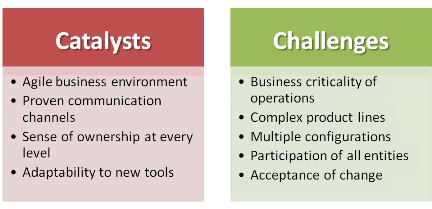
Just rewind to the 1990’s, when software development was done using waterfall model, the word ‘Change Management’ was playing a spoilsport for all the wishful thinking. The software engineering team used to blame it on the business interface team why the system release was getting impacted both in budget and quality.
The business interface team, on the other hand, would suspect the so-called genius software engineering team for their inability to incorporate small changes into the broad business functions that remained unchanged. The process groups and IT governance structure would rule the court with dreadful laws and bye laws of ‘The Change Management’ to resolve disputes.
Now, flash, and come forward a decade in 200x and witness an enthusiastic crowd of software buddies cheering “Agile! Agile!” The ills of waterfall have been cured with dopes of agile – the biggest change is change management itself. Now the business interface team has a direct say in the design and plan of the sprints and is able to add new stuff into the backlog. There is no big deal of new demands from business getting detailed out into software specifications, then further into design changes, then into program specs changes, then into test specs changes and so on. But with initial enthusiasm cooling down and the software getting more and more complex, come to 2015, and it is time to wonder, “Is that Change Management Genie out the bottle again?”
Consider this example (with the usual disclaimers that all the names are purely fictitious…..):
‘ABC’ – a midsize software products company in the healthcare providers’ domain in the US sells its products as COTS software to the big players as well as offers hosted options to the nimble ones. Although it is an established company being in business since 1995, it sometimes gets thrown into the ‘start-up’ gear due to sweeping market trends like SOX and Obama-care. So far, it has managed to ride such ripples and tsunamis with tactical and strategic just-in-time approach. It already has so many complex factors in place such as state-wise product lines, configurations supporting various technical environments, product implementation and support services, hosted product administration services and partly outsourced development and operations. Now ABC is staring at a big change – SMAC i.e. Social, Mobile, Analytics, Cloud. Has decided to excel in their social media presence from being a passive one to an active one. Aspires to provide as many services through mobile to the end users viz. subscribers, paramedics, doctors. Has taken up analytics to improve business on both the fronts – backend operations and frontend sales. ABC management is also planning to tap the potential of cloud for their business operations.
This seems like a big agenda for ABC. This encompasses various entities in their business such as the marketing folks, the development teams, outsourcing service providers, the product support teams, the operations team, the decision makers, why, even their customers and product users. Also, these four faculties of change seem to be intertwined into each other as social media activity must consider the new mobile and cloud capabilities being offered, while analytics should consider not only the present performance indicators but also the new ones implied by mobile, social and cloud. Of course, this whole song and drama has to happen while the normal business runs as usual i.e. the product upgrade released, product support continued and hosted operation running. ABC chooses Ms. Anita as the leader responsible for this change in 2015 and internally publishes a new transformational initiative called ‘Revolution with ABC’.
As the Head of Operations and a member of the Senior Management Council, Anita knows the big picture with all jigsaw pieces fitted together and also the small nuts and bolts that keep the machinery running. She sits down to take stock of the situation to put together her plan of action. Here is what she collects as the catalysts and challenges in her task:

Now, Anita decides to take a bottom up approach of setting individual units in motion followed by integrational and supervisory effort. How? How will she invigorate the product development department to plan for so many changes in their software product line? How will she drive her operations department to go for cloud provisioning coexisting with in-house hosting under the light of new products getting released from the product development department? How will she ensure that all the affected entities across the extended enterprise are communicated and connected? Don’t you think Anita is facing the challenge of unbottled Genie?
Read the next post on this topic to understand how a well-engineered approach of software product line change management can be employed by Anita.






